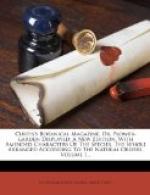[Illustration: No. 15]
The fragrant Jonquil is a native of Spain, flowers in the open ground, about the latter-end of April, or beginning of May, and will thrive in almost any soil or situation, but prefers, as most bulbs do, a fresh loamy earth; indeed such a soil is favourable to the growth of most plants, as being exempt from a variety of subterraneous insects, which are apt to infest ground which has been long cultivated.
It is found in the gardens with double flowers.
Our plant accords exactly with the description of Linnaeus, above quoted, but must be carefully distinguished from some others very similar to it.
[16]
Iris variegata. Variegated Iris.
Class and Order.
Triandria Monogynia.
Generic Character.
Corolla 6-partita; Petalis alternis, reflexis. Stigmata petaliformia.
Specific Character and Synonyms.
IRIS variegata corollis barbatis, caule subfolioso longitudine foliorum multifloro. Linn. Spec. Pl. p. 56.
IRIS latifolia pannonica, colore multiplici. Bauh. Pin. 31.
The yellow variable Flower-de-Luce. Parkinson Parad. p. 182.
[Illustration: No. 16]
This species of Iris, inferior to few in point of beauty, is a native of the hilly pastures of Hungary, and flowers in our gardens in the month of May, and beginning of June. It is a hardy perennial, requires no particular treatment, and may be easily propagated by parting its roots in Autumn.
[17]
Cactus flagelliformis. Creeping Cereus.
Class and Order.
Icosandria Monogynia.
Generic Character.
Calyx 1-phyllus, superus, imbricatus. Corolla multiplex. Bacca 1-locularis, polysperma.
Specific Character.
CACTUS flagelliformis repens decemangularis. Linn. Syst. Vegetab. ed. 14 p. 460.
CEREUS flagelliformis. Miller’s Gard. Dict. ed. 6. 4_to._
[Illustration: No. 17]
Grows spontaneously in South-America, and the West-Indies, flowers in our dry stoves early in June, is tolerably hardy, and will thrive even in a common green-house, that has a flue to keep out the severe frosts.
It is superior to all its congeners in the brilliancy of its colour, nor are its blossoms so fugacious as many of the other species.
No plant is more easily propagated by cuttings; these Miller recommends to be laid by in a dry place for a fortnight, or three weeks, then to be planted in pots, filled with a mixture of loam and lime rubbish, having some stones laid in the bottom of the pot to drain off the moisture, and afterwards plunged into a gentle hot-bed of Tanners bark, to facilitate their rooting, giving them once a week a gentle watering: this business to be done the beginning of July.




